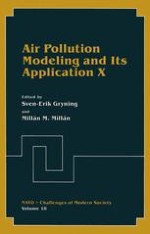1994 | OriginalPaper | Buchkapitel
The Use of Simultaneous Confidence Intervals to Evaluate Carbon Monoxide (CO) Intersection Models
verfasst von : Donald C. DiCristofaro, David G. Strimaitis, Thomas N. Braverman, William M. Cox
Erschienen in: Air Pollution Modeling and Its Application X
Verlag: Springer US
Enthalten in: Professional Book Archive
Aktivieren Sie unsere intelligente Suche, um passende Fachinhalte oder Patente zu finden.
Wählen Sie Textabschnitte aus um mit Künstlicher Intelligenz passenden Patente zu finden. powered by
Markieren Sie Textabschnitte, um KI-gestützt weitere passende Inhalte zu finden. powered by
The United States (U.S.) Environmental Protection Agency (EPA) has recently evaluated the performance of eight modeling techniques in simulating carbon monoxide (CO) concentrations at six intersections in New York City (EPA, 1992). The eight intersection modeling techniques evaluated include: CAL3QHC (1985 Highway Capacity Manual Modified CAL3Q Model), FHWAINT (Federal Highway Administration (FHWA) Intersection Model), GIM (Georgia Intersection Model), EPAINT (EPA Intersection Model), CALINE4 (California Line Source Model), VOL9MOB4 (MOBILE4 Modified Volume 9 Technique), TEXIN2 (Texas Intersection Model), and IMM (Intersection Midblock Model). The New York City database includes hourly meteorological, carbon monoxide, and traffic observations for six intersections in the city. This paper describes a method developed by EPA for aggregating component results of model performance into a single performance measure which is then used to compare the overall performance of the modeling techniques.
